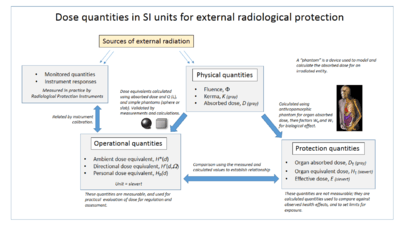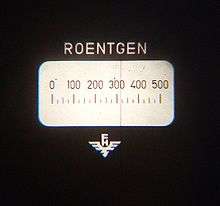Dosimeter
A radiation dosimeter is a device that measures exposure to ionizing radiation. It has two main uses: for human radiation protection and for measurement of dose in both medical and industrial processes.[1][2][3]
Personal dosimeters[4]
The personal ionising radiation dosimeter is of fundamental importance in the disciplines of radiation dosimetry and radiation health physics and is primarily used to estimate the radiation dose deposited in an individual wearing the device.
Ionising radiation damage to the human body is cumulative, and is related to the total dose received, for which the SI unit is the sievert. Workers exposed to radiation, such as radiographers, nuclear power plant workers, doctors using radiotherapy, those in laboratories using radionuclides, and HAZMAT teams are required to wear dosimeters so a record of occupational exposure can be made. Such devices are known as "legal dosimeters" if they have been approved for use in recording personnel dose for regulatory purposes.
Dosimeters can be worn to obtain a whole body dose and there are also specialist types that can be worn on the fingers or clipped to headgear, to measure the localised body irradiation for specific activities.
Types
Common types of personal dosimeters for ionizing radiation include:
Electronic personal dosimeter (EPD)
The electronic personal dosimeter (EPD) is an electronic device that has a number of sophisticated functions, such as continual monitoring which allows alarm warnings at preset levels and live readout of dose accumulated. These are especially useful in high dose areas where residence time of the wearer is limited due to dose constraints. The dosimeter can be reset, usually after taking a reading for record purposes, and thereby re-used multiple times.
MOSFET dosimeter
MOSFET dosimeters [5] are now used as clinical dosimeters for radiotherapy radiation beams. The main advantages of MOSFET devices are:
1. The MOSFET dosimeter is direct reading with a very thin active area (less than 2 μm).
2. The physical size of the MOSFET when packaged is less than 4 mm.
3. The post radiation signal is permanently stored and is dose rate independent.
Gate oxide of MOSFET which is conventionally silicon dioxide is an active sensing material in MOSFET dosimeters. Radiation creates defects (acts like electron-hole pairs) in oxide, which in turn affects the threshold voltage of the MOSFET. This change in threshold voltage is proportional to radiation dose. Alternate high-k gate dielectrics like Hafnium dioxide[6] and Aluminum oxides are also proposed as a radiation dosimeters.
Film badge dosimeter
Film badge dosimeters are for one-time use only. The level of radiation absorption is indicated by a change to the film emulsion, which is shown when the film is developed.
Quartz fiber dosimeter
Quartz fiber dosimeters are charged to a high voltage. As the gas in the dosimeter chamber becomes ionized by radiation the charge leaks away, causing the fiber indicator to change against a graduated scale.[7]
Thermoluminescent dosimeter (TLD)
A thermoluminescent dosimeter measures ionizing radiation exposure by measuring the intensity of visible light emitted from a crystal in the detector when heated. The intensity of light emitted is dependent upon the radiation exposure.
Both the quartz fiber and film badge types are being superseded by the TLD and the EPD.
Radiation protection dose quantities

The dosimeter plays an important role within the international radiation protection system developed by the International Commission on Radiological Protection (ICRP) and the International Commission on Radiation Units and Measurements (ICRU). This is shown in the accompanying diagram.
Protection quantities
The protection quantities are used as "limiting quantities" to specify exposure limits to ensure that the occurrence of stochastic health effects is kept below unacceptable levels and that tissue reactions are avoided.[8][9][10] These quantities cannot be practically measured and are a calculated value of irradiation of organs of the human body, which is arrived at by using an anthropomorphic phantom. This is a 3D computational model of the human body which attempts to take into account a number of complex effects such as body self-shielding and internal scattering of radiation.[11]
As protection quantities cannot practically be measured, operational quantities are used to relate them to practical radiation instrument and dosimeter responses.[12]
Operational quantities
Operational quantities are aimed at providing an estimate or upper limit for the value of the protection quantities related to an exposure. They are used in practical regulations or guidance. These relate real-life operational instrument measurements and responses to the calculated protection quantities.[13]
Personal dose equivalent, Hp(d), is defined by the ICRP as the dose equivalent in soft tissue at an appropriate depth, d, below a specified point on the human body. The specified point is usually given by the position where the individual’s dosimeter is worn.[14]
Instrument and dosimeter response
This is an actual reading obtained from such as an ambient dose gamma monitor, or a personal dosimeter. The dosimeter is calibrated in a known radiation field to ensure display of accurate operational quantities and allow a relationship to known health effect. The personal dose equivalent is used to assess dose uptake, and allow regulatory limits to be met. It is the figure usually entered into the records of external dose for occupational radiation workers.
Dosimeter calibration
The "slab" phantom is used to represent the human torso for calibration of whole body dosimeters. The IAEA states "The slab phantom is 300 mm × 300 mm × 150 mm depth to represent the human torso".[15]
Process irradiation verification
Manufacturing processes that treat products with ionizing radiation, such as food irradiation, use dosimeters to calibrate doses deposited in the matter being irradiated. These usually must have a greater dose range than personal dosimeters, and doses are normally measured in the unit of absorbed dose: the gray (Gy). The dosimeter is located on or adjacent to the items being irradiated during the process as a validation of dose levels received.
Gallery
 QFD - These are now largely superseded
QFD - These are now largely superseded View of QFD reading
View of QFD reading Russian Sosna radiometer-dosimeter (Front view)
Russian Sosna radiometer-dosimeter (Front view) Russian Sosna radiometer-dosimeter (Rear view)
Russian Sosna radiometer-dosimeter (Rear view) Russian Radex RD1503
Russian Radex RD1503 Soeks 01M
Soeks 01M Swiss dosimeter SA-05A
Swiss dosimeter SA-05A
See also
- Comparison of dosimeters
- Geiger counter
- Scintillation counter
- Ionisation chamber
- Royal Observer Corps
- Operational instruments of the Royal Observer Corps
References
- ↑ http://iopscience.iop.org/0031-9155/59/20/R303/article
- ↑ "Advances in kilovoltage x-ray beam dosimetry". Physics in Medicine and Biology. 59: R183–R231. doi:10.1088/0031-9155/59/6/R183.
- ↑ "Polymer gel dosimetry". Physics in Medicine and Biology. 55: R1–R63. doi:10.1088/0031-9155/55/5/R01.
- ↑ phd1
- ↑ http://www.mosfet.ca/global/pdf/technotes/te_4.pdf
- ↑ V. S. Senthil Srinivasan and Arun Pandya, ″Dosimetry aspects of hafnium oxide metal-oxide-semiconductor (MOS) capacitor″, Thin Solid Films Volume 520, Issue 1, 31 October 2011, Pages 574–577
- ↑ Frame, Paul (2007-07-25). "Pocket Chambers and Pocket Dosimeters". Health physics historical instrument museum collection. Oak Ridge Associated Universities. Retrieved 2008-11-08.
- ↑ ICRP publication 103, paragraph 112
- ↑ ICRP publication 103, paragraph B50
- ↑ "In 1991, the International Commission on Radiological Protection (ICRP) [7] recommended a revised system of dose limitation, including specification of primary limiting quantities for radiation protection purposes. These protection quantities are essentially unmeasurable" - IAEA Safety report 16
- ↑ ICRP publication 103, paragraph B64
- ↑ ICRP publication 103, paragraph B146
- ↑ ICRP publication 103, paragraph B147
- ↑ ICRP pub 103 glossary
- ↑ IAEA safety report 16
External links
| Wikimedia Commons has media related to Dosimeters. |
- A photographic list of radiation dosimeters
- Space Radiation Dosimetry: Lessons Learned and Recommendations